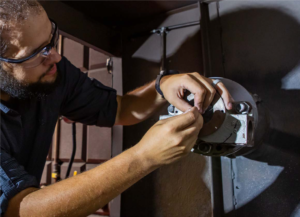2021 CTMA Magazine: Cold Spray Advances Vision of the Shipyard of the Future
 By Phil Callihan, NCMS
By Phil Callihan, NCMS
NCMS has partnered with the U.S. Navy to leverage commercial AM technology for innovative repairs providing defense-essential M&S. Such capabilities are used across NAVSEA, NAVAIR and the U.S. Marine Corps but have a broad application across the entire DOD. AM is a disruptive technology that holds substantial promise to help achieve in situ maintenance and repair while in remote locations or underway. Using additive repair technologies, including cold spray, can reduce M&S costs, improve availability, and extend the life of maritime assets.
This initiative is specifically utilizing cold spray, a solid-state coating deposition method to fabricate or repair damaged components. Cold spray has the capability to add new metal to worn surfaces so that critical features can be re-machined back to tolerance, allowing parts previously destined for scrap to be reused. It provides an incredibly powerful tool for the commercial maritime industry to quickly refurbish a damaged or out-of-tolerance part and simply reuse it in the near or distant future as a replacement part. Through this initiative, the Navy is demonstrating capabilities for the DOD.
Cold spray technologies were demonstrated in three Naval shipyards, testing a variety of equipment including multiple spray devices, robots, spray booths, and atmospheric control equipment. Goals included the development of engineer and operator training, insight into the cold spray application process, and quality controls for surface restoration. R&D of Qualified Spray Procedures (QSPs) is continuing, as well as the demonstration of a high-volume capability to produce unique metallic cold spray powders. The use of drones to inspect Naval vessels to identify potential damage and monitor the status of repairs is also being evaluated.
The overarching objective is to expand the scope of potential repairs available to ships while underway and avoid dry docks or piers unless completely necessary. If an organization can eliminate some instances of repair that previously would have required shore facilities by using onboard technologies, mission availability will be increased. By relying on cold spray to create some repair parts, ships could also benefit through a reduction in their onboard inventory. This will result in a lighter weight vessel with more capacity to carry cargo rather than spare parts.
While focused on ships, the results are applicable to many other industries, such as truck and rail transport, aircraft, and situations where repairs adversely affect deliverables and time schedules. Technicians using cold spray for repairs will not only gain experience, but also upgrade their skillsets, making themselves more marketable, employable, and valuable to their organizations.
The initiative expands the deployment and utility of cold spray technology and contributes to sustainable long-term economic benefits while providing a broad spectrum of job opportunities for large and small companies alike. This innovative technology will enable non-critical repairs to take place on-demand, keeping the vessel on-mission and ready for duty.
